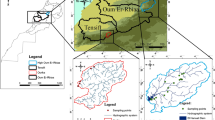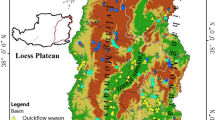Abstract
Snowmelt infiltration is one of the key factors that trigger landslides. This study focused on characterization of snowmelt infiltration in the Shimekake landslide block in northeastern Japan via long-term monitoring of major ion concentrations and stable isotope ratios of groundwater and precipitation. Results revealed seasonal variations of the d-excess values of precipitation, which were significantly higher in winter. Likewise, the d-excess values of the groundwater increased during the melting season. Groundwaters collected from 17 sites in the landslide blocks were classified into five types based on a comparison of hydrochemical and isotopic compositions between melting and non-melting seasons. Groundwater with significantly higher d-excess values during the melting season was diluted by infiltration of snowmelt, which resulted in a decrease in ion concentrations. Three groundwater types underwent large changes in electrical conductivity and/or ion concentrations during the melting season, even though the d-excess values did not change significantly. These groundwaters were inferred to have been affected by the arrival of groundwater with different chemical compositions as a result of elevation of the water table by infiltration of snowmelt. The fifth type of groundwater was less affected by snowmelt infiltration. The results indicated the existence of preferential subsurface flows and a heterogeneous flow system in this landslide block.

taken from the Geospatial Information Authority of Japan. The geological cross-section was modified from Terada et al. (2010)













Similar content being viewed by others
References
Asch TV, Buma J, Beek LV (1999) A view on some hydrological triggering systems in landslides. Geomorphology 30(12):25–32
Bogaard TA, Greco R (2016) Landslide hydrology: from hydrology to pore pressure. Wires Water 3:439–459
Bogaard T, Guglielmi Y, Marc V, Emblanch C, Bertrand C, Mudry J (2007) Hydrogeochemistry in landslide research: a review. Bull Soc Geol Fr 178(2):113–126
Brownlow AH (1979) Geochemistry. Prentice-Hall, New Jersey
Cappa F, Guglielmi Y, Soukatchoff VM, Mudry J, Bertrand C, Charmoille A (2004) Hydromechanical modeling of a large moving rock slope inferred from slope levelling coupled to spring long-term hydrochemical monitoring: example of the La Clapière landslide (Southern Alps, France). J Hydrol 291:67–90
Cervi F, Ronchetti F, Martinelli G, Bogaard TA, Corsini A (2012) Origin and assessment of deep groundwater inflow in the Ca’ Lita landslide using hydrochemistry and in situ monitoring. Hydrol Earth Syst Sci 16:4205–4221
Craig H (1961) Isotopic variations in meteoric waters. Science 133:1702–1703
Dansgaard W (1964) Stable isotopes in precipitation. Tellus 16:436–468
Deiana M, Cervi F, Pennisi M, Mussi M, Bertrand C, Tazioli A, Corsini A, Ronchetti F (2018) Chemical and isotopic investigations (δ18O, δ2H, 3H, 87Sr/86Sr) to define groundwater processes occurring in a deep-seated landslide in flysch. Hydrogeol J 26:2669–2691
Deiana M, Mussi M, Pennisi M, Boccolari M, Corsini A, Ronchetti F (2020) Contribution of water geochemistry and isotopes (δ18O, δ2H, 3H, 87Sr/86Sr and δ11B) to the study of groundwater flow properties and underlying bedrock structures of a deep landslide. Environ Earth Sci 79(1):1–15
Gariano SL, Guzzetti F (2016) Landslides in a changing climate. Earth-Sci Rev 162:227–252
Geospatial Information Authority of Japan. GSI Map. https://maps.gsi.go.jp/. Accessed 1 June 2020
Guglielmi Y, Bertrand C, Compagnon F, Follacci JP, Mudry J (2000) Acquisition of water chemistry in a mobile fissured basement massif: its role in the hydrogeological knowledge of the La Clapière landslide (Mercantour massif, southern Alps, France). J Hydrol 229:138–148
IAEA/GNIP (2014) Precipitation Sampling Guide (V2.02). http://www-naweb.iaea.org/napc/ih/documents/other/gnip_manual_v2.02_en_hq.pdf. Accessed 28 May 2020
Ichiyanagi K, Tanoue M (2016) Spatial analysis of annual mean stable isotopes in precipitation across Japan based on an intensive observation period throughout 2013. Isot Environ Health S 52:353–362
Japan Economic Planning Agency (1964) Fundamental Land Classification Survey “Yudonoyama”. Japan Economic Planning Agency, Japan (in Japanese only, English abstract)
Japan Landslide Society (2002) Landslides in Japan. Japan Landslide Society National Conference of Landslide Control. https://japan.landslide-soc.org/wp19/wp-content/uploads/2019/05/2002.pdf
Kabeya N, Katsuyama M, Kawasaki M, Ohte N, Sugimoto A (2007) Estimation of mean residence times of subsurface waters using seasonal variation in deuterium excess in a small headwater catchment in Japan. Hydrol Process 21:308–322
Kawagoe S, Kazama S, Sarukkalige PR (2009) Assessment of snowmelt triggered landslide hazard and risk in Japan. Cold Reg Sci Technol 58(3):120–129
Kim H, Bishop JKB, Dietrich WE, Fung IZ (2014) Process dominance shift in solute chemistry as revealed by long-term high-frequency water chemistry observations of groundwater flowing through weathered argillite underlying a steep forested hillslope. Geochim Cosmochim Acta 140:1–19
Kosugi K, Fujimoto M, Katsura S, Kato H, Takahisa M (2011) Localized bedrock aquifer distribution explains discharge from a headwater catchment. Water Resour Res 47:W07530
Li W, Wang MY, Liu LY, Yan Y (2015) Assessment of long-term evolution of groundwater hydrochemical characteristics using multiple approaches: a case study in Cangzhou, Northern China. Water 7:1109–1128
Lin PY, Tsai LLY (2012) A hydrochemical study of Hungtsaiping landslide area, Nantou. Taiwan Environ Earth Sci 67:1045–1060
Madritsch H, Millen BMJ (2007) Hydrogeologic evidence for a continuous basal shear zone within a deep-seated gravitational slope deformation (Eastern Alps, Tyrol, Austria). Landslides 4:149–162
Mikoš M, Četina M, Brilly M (2004) Hydrologic conditions responsible for triggering the Stože landslide, Slovenia. Eng Geol 73:193–213
Nagamizo S (1979) On some proposal methods for division of ground water in landslide area. Landslide 15(4):28–32 (in Japanese only, English abstract)
Osawa H, Matsushi Y, Matsuura S, Okamoto T, Shibasaki T, Hirashima H (2018) Seasonal transition of hydrological processes in a slow-moving landslide in a snowy region. Hydrol Process 32:2695–2707
Padilla C, Onda Y, Iida T, Takahashi S, Uchida T (2014) Characterization of the groundwater response to rainfall on a hillslope with fractured bedrock by creep deformation and its implication for the generation of deep-seated landslides on Mt. Wanitsuka, Kyushu Island. Geomorphology 204:444–458
Peng TR, Wang CH, Lai TC, Ho FSK (2007) Using hydrogen, oxygen, and tritium isotopes to identify the hydrological factors contributing to landslides in a mountainous area, central Taiwan. Environ Geol 52:1617–1629
Peng TR, Wang CH, Hsu SM, Wang GS, Su TW, Lee JF (2010) Identification of groundwater sources of a local-scale creep slope: Using environmental stable isotopes as tracers. J Hydrol 381:151–157
Shao W, Bogaard T, Bakker M, Betrti M (2016) The influence of preferential flow on pressure propagation and landslide triggering of the Rocca Pitigliana landslide. J Hydrol 543:360–372
Shibasaki T, Yagi H, Tohoku branch Japan Landslide Society (2018) Snowmelt-induced landslide disaster–2018 Agatsu landslide in Kitakata City, Fukushima Prefecture. J Jpn Landslide Soc 55(4):182–184 (in Japanese only)
Tan H, Wen X, Rao W, Bradd J, Huang J (2016) Temporal variation of stable isotopes in a precipitation–groundwater system: implications for determining the mechanism of groundwater recharge in high mountain–hills of the Loess Plateau, China. Hydrol Process 30:1491–1505
Terada T, Kamata T, Mori K, Nakahara M (2010) Emergent and permanent preventive measures for 2009 SHIMEKAKE landslide disaster, Tsuruoka-City. Yamagata Geotech Eng Mag 58(11):36–37 (in Japanese only)
Tsuchihara T, Okuyama T, Yoshimoto S, Shirahata K, Ishida S (2014) Sulfur hexafluoride-based age dating of groundwater in the Shimekake landslide in Yamagata, Japan. IDRE J 294:65–74 (in Japanese only, English abstract)
Tsuchihara T, Shirahata K, Yoshimoto S, Ishida S (2019) National-scale variations in the stable isotopic compositions of irrigation-pond and spring waters across Japan. Paddy Water Environ 17:429–438
Vallet A, Bertrand C, Mudry J, Bogaard T, Fabbri O, Baudement C, Régent B (2015) Contribution of time-related environmental tracing combined with tracer tests for characterization of a groundwater conceptual model: a case study at the Séchilienne landslide, western Alps (France). Hydrogeol J 23:1761–1779
Watanabe N, Washizu F, Oki Y, Sato O (1995) Chemical characteristics of groundwaters from the Matsunoyama landslide area, Niigata Prefecture. J Jpn Landslide Soc 32(3):32–40 (in Japanese only, English abstract)
Wieczorek GF (1996) Landslide triggering mechanisms. In: Turner AK, Schuster RL (eds) Landslides: investigation and mitigation. Transportation Research Board, National Research Council, Washington, DC, Special Report, pp 76–90
Yamada T, Mitsunaga T, Shigihara Y, Kubota T, Yakura H, Matsuo S (2017) On the movement of a large-scale landslide during snow and snowmelt season. J Jpn Landslide Soc 54(6):269–276 (in Japanese only, English abstract)
Yan RX, Peng JB, Huang QB, Chen LJ, Kang CY, Shen YJ (2019) Triggering influence of seasonal agricultural irrigation on shallow loess landslides on the south Jingyang plateau. China Water 11:1474
Yoshimura K, Ichiyanagi K (2009) A reconsideration of seasonal variation in precipitation deuterium excess over East Asia. J Jpn Soc Hydrol Water Res 22:262–276 (in Japanese only, English abstract)
Acknowledgements
The authors express their gratitude to the Tohoku Regional Agricultural Administration Office for their help with our surveys.
Funding
This study was supported by Japan Society for the Promotion of Science Grants-in-Aid for Scientific Research (KAKENHI) (grant numbers 25892030 and 15K18760) and “Impact Assessment of the Increase of the Extremes on the Vulnerability of Water/Land Resources and Forestry” Project research of the Ministry of Agriculture, Forestry and Fisheries, Japan.
Author information
Authors and Affiliations
Corresponding author
Ethics declarations
Conflict of interest
The authors declare no conflicts of interest or competing interests.
Additional information
Publisher's Note
Springer Nature remains neutral with regard to jurisdictional claims in published maps and institutional affiliations.
Rights and permissions
About this article
Cite this article
Tsuchihara, T., Okuyama, T., Shirahata, K. et al. Hydrochemical and isotopic investigation to characterize the effect of snowmelt infiltration on groundwater in a snowy landslide area of Japan. Environ Earth Sci 80, 444 (2021). https://doi.org/10.1007/s12665-021-09722-3
Received:
Accepted:
Published:
DOI: https://doi.org/10.1007/s12665-021-09722-3




